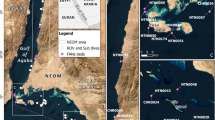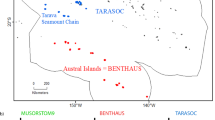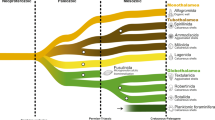Abstract
BIOCOENOSES of planktonic foraminifera are usually accepted to be good indicators of different sorts of oceanic water masses1, and it is assumed that their ecological requirements have not changed drastically during the Quaternary2. Their remains have, therefore, been used for approximately the past 40 yr (ref. 3) to study, qualitatively as well as quantitatively, the palaeoclimatic record4 preserved in young, calcareous, deep-sea sediments. Despite this, however, the mechanism of the formation of death assemblages and sediment assemblages is very poorly understood, mainly because the distribution pattern of planktonic foraminiferal biocoenoses and their output of shell material is only poorly known.
This is a preview of subscription content, access via your institution
Access options
Subscribe to this journal
Receive 51 print issues and online access
$199.00 per year
only $3.90 per issue
Buy this article
- Purchase on Springer Link
- Instant access to full article PDF
Prices may be subject to local taxes which are calculated during checkout
Similar content being viewed by others
References
Bé, A. W. H., in Oceanic Micropaleontology (edit. by Ramsay, A. T.), (in the press).
Kipp, N. G., Mem. geol. Soc. Am., North Atlantic CLIMAP volume (in the press).
Schott, W., Wiss. Ergebn. dt. atlant. Exped. ‘Meteor’, 3 (3B), 43–134 (1935).
Imbrie, J., and Kipp, N. G., in ‘The late Cenozoic glacial ages’ (edit. by Turekian, K.), 71–181 (Yale University Press, New Haven, 1971).
Smith, R. L., Oceanogr. mar. Biol. A. Rev., 6, 11–46 (1968).
Tomczak, M., ‘Meteor’ Forsch. Ergebn., 8.7, 1–109 (1970).
Mittelstaedt, E., and Koltermann, K. P., Dt. hydrogr. Z., 26(5), 193–215 (1973).
Seibold, E., ‘Meteor’ Forsch. Ergebn., C. 10, 17–38 (1972).
Thiede, J., ‘Meteor’ Forsch. Ergebn., C. (in the press).
Bé, A. W. H., Micropaleontology, 5(1), 77–100 (1959); 6(4), 373–392 (1960); Bé, A. W. H., and Hamlin, W. H., Micropaleontology, 13(1), 87–106 (1967).
Weichart, G., Dt. Hydrogr. Z., 23(2), 49–60 (1970); Umschau Wiss. Techn., 26, 856 (1970).
Imbrie, J., and van Andel, T. H., Bull. geol. Soc. Am., 75(11), 1131–1156 (1964).
Klovan, J. E., and Imbrie, J., J. int. Assoc. mathem. Geol., 3(1), 61–77 (1971).
Miró, M. D. de, Res. Exped. cient. Cornide de Saavedra, Barcelona, 2, 95–108 (1973).
Jones, J. L., Micropaleontology, 13(4), 489–501 (1967); Proc. Symp. Oceanogr. Fish Resources, Atlantic (ICITA and GTS Results, Unesco, Paris), 213–230 (1969).
Tomczak, M., ‘Meteor’ Forsch. Ergebn., A. 13 (in the press).
Ericson, D. B., and Wollin, G., Science, 162, 1227–1234 (1968); ibid., 167, 1483–1485 (1970).
Berger, W. H., Mar. Geol., 8(2), 111–138 (1970).
Parker, F. L., and Berger, W. H., Deep Sea Res., 18(1), 73–107 (1971).
Author information
Authors and Affiliations
Rights and permissions
About this article
Cite this article
THIEDE, J. Distribution of foraminifera in surface waters of a coastal upwelling area. Nature 253, 712–714 (1975). https://doi.org/10.1038/253712a0
Received:
Revised:
Published:
Issue Date:
DOI: https://doi.org/10.1038/253712a0
This article is cited by
-
Trophic niche separation of two non-spinose planktonic foraminifers Neogloboquadrina dutertrei and Pulleniatina obliquiloculata
Progress in Earth and Planetary Science (2022)
-
Distribution and environmental implications of planktonic foraminifera in the surface sediments of southwestern part of Bay of Bengal, India
Journal of Sedimentary Environments (2021)
-
Modern planktic foraminifera
Paläontologische Zeitschrift (2005)
Comments
By submitting a comment you agree to abide by our Terms and Community Guidelines. If you find something abusive or that does not comply with our terms or guidelines please flag it as inappropriate.



